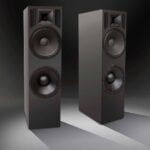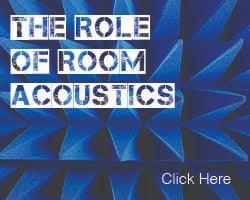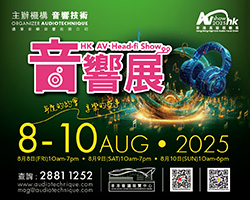Hifi Pig takes the opportunity of the PMC 30th Anniversary to have a chat with Peter Thomas, PMC’s owner and founder.
2021 sees one of our best known British Hifi brands, PMC, the Professional Monitor Company, celebrating its 30th birthday.
As big a name in professional audio as they are Hifi, PMC are continuing to expand into new fields such as that of Custom Installation for integrated home cinema setups and as a distributor of a select group of international Hifi brands through PMC Distribution UK.
30 Years Of PMC
The brand was born way back in 1991, back when the UK was leaping about to the repetitive beats of rave culture, and probably before some of you reading this were born yourselves.
PMC was established by Peter Thomas, then a manager and engineer at BBC Music Studios, and his friend Adrian Loader, an engineer at FWO Bauch. The pair were dissatisfied with the speakers that were commercially available at the time for both studio and home use, so they began designing their own, developing transmission line technology and, after four prototypes, created the first BB5 (big box version 5), which they sold to the BBC.
BBC Studios
Their first year was a busy one also seeing the launch of PMC’s first domestic loudspeaker, the LB1, at the time the world’s smallest transmission line design, and the BB5 XBD Active including PMC designed and built active electronics, which was installed in BBC Maida Vale Studios. The pair also exhibited at their first trade show, the Association of Professional Recording Services in London and, as anyone that has attended Hifi Shows since knows, PMC has gone on to be a ‘must visit’ exhibitor at Hifi Shows the world over.

Status Quo’s Francis Rossi installed PMC IB2s and TB2S in his personal studio and proclaimed them “f**king brilliant”
Maida Vale To Nashville
By the next year, 1992, PMC had opened their first factory and, through the following years, went on to be highly in demand, both in the BBC and far beyond, in concert halls and recording studios including the world-famous Metropolis Studios and for Hollywood’s film scoring elite. Big-name celebrities like Brian May, Stevie Wonder and Robbie Williams installed PMC speakers in their own studios and in the USA the brand was used in some of the most famous recording and mastering studios from Nashville to New York. Status Quo’s Francis Rossi installed PMC IB2s and TB2S in his personal studio and proclaimed them “f**king brilliant”. In Germany PMC were used for recording classical music for Deutsche Gramophon and Harmonia Mundi, and by electronic pioneers Kraftwerk in their Kling Klang studios in Düsseldorf
Sadly, Adrian Loader passed away in 1998. The PMC AML1 Active Monitor was named in honour of the brand’s co-founder later that year.
Made In Britain
The PMC client list, both for professional and home use, reads like a Who’s Who hall of fame stretching throughout the music industry and beyond…of course not forgetting the most important people of all, the thousands of people just like you, our readers who have been buying these proudly ‘Made in Britain’ speakers for the past 30 years and will, undoubtedly, continue to do so for many years to come.
We would like to take this opportunity to wish Peter and all the team at PMC a very happy 30th anniversary!
Hifi Pig caught up with Peter Thomas and had a chat, looking both back over the last 30 years and forwards to the future.
Hifi Pig (HP): What do you think your time at the BBC brought to the table?
Peter Thomas (PT): The opportunity to draw on decades of accumulated audio experience. The BBC had been designing and building much of its equipment since the 1930s. This included microphones, recording desks, amplifiers, turntables and of course speakers. The training you received was incredible…and intensive. Understanding all elements in the audio chain, from microphone through to the radio receiver and playback in your home really gave you a detailed knowledge of every piece of equipment and its strengths and weaknesses This had an enormous influence on me when it came to designing loudspeakers. I knew I had to look at every element and understand its effects on the final design. This ‘holistic’ or balanced approach has certainly put us in good stead and its one of our guiding principles.
They had also developed and honed a method of designing speakers for over 50 years which led them to a combination of measurement and multiple listening tests to achieve their design goals. That’s another essential procedure we have adopted in our development of PMC designs.
HP: What do you see as the biggest achievement for PMC in the last 30 years?
PT: Helping audio professionals to capture music in the best possible quality and advancing speaker design so we can enjoy the same experience in the home. We can now listen to recordings made in the 1950s and 60s in a quality that they could not reproduce at the time. I think we have helped recording standards move forward so music captured today will sound better today and in years to come.
HP: If you could go back 30 years, with all the knowledge you have gained, what bit of advice would you give yourself in 1991?
PT: When we started our business, our passion was to create something really special with the main focus on the product and what it can do that was better than anything else available. It’s key not to lose that sort of drive, it ensures you don’t produce a ‘me-too’ product. But when you are so deeply embroiled its important you see the bigger business picture, so get a good accountant! It will help you realise your goals.
HP: You are well known for having a collection of vintage audio products. If you were to be able to keep just one item what would it be and why?
PT: It would have to be the Gale GT2101 turntable. A stunning piece of design and so advanced for its time. The platter is driven directly via a DC brushless motor powered from an outboard motor controller. The motor features a floating magnetic bearing, and the speed is quartz locked with a three-digit LED display showing the speed. This turntable can be vari-speeded between 10 and 99.9 rpm!
And this is in 1975. Incredible. Its rarity is also an attraction. Estimates range from 50 to 100 as the total production run and the customers were the rich and famous of the day.
It would be fair to say that its styling owed a great deal to the IMF 300 turntable released in the early 1970s which is also a rare item in our collection.
HP: What record would you play on/through the above?
PT: Well as Elton John was rumoured to own at least one, it would have to be Captain, Fantastic and the Brown Dirt Cowboy album released at the same time as the turntable. This is a great recording on the original vinyl release. Gus Dudgeon produced and captured some amazing performances in his career.
HP: Who has been your most memorable client over the years?
PT: For me personally that would have to be Stevie Wonder. He had installed our PMC BB5s in his Wonderland Studios in Los Angeles and while visiting the UK phoned me to ask for some small monitors and to visit him at his hotel to discuss speaker design. During a memorable evening, he invited me as his personal guest to a private concert held at the Natural History Museum. Some months later I visited his studio in the USA to do a performance check on his studio monitoring as he was remastering all his albums with our speakers. There is nothing quite like being at the recording desk with Stevie Wonder standing next to you performing one of his songs live!
HP: Going forward (and getting out the crystal ball), what kind of developments do you think will be seen in both pro and home audio in the next few years?
PT: The TV and Music industries are investing heavily in Dolby Atmos so that is a major focus for us currently in the professional field. Many large studios are being constructed around the world and the demands for high level, high end performance speakers make PMC a natural choice. Our Advanced Transmission Line cabinet technology allows us to achieve those requirements for our clients.
In the home, that same technology allows us to design speakers that are smaller but still perform like large speakers. That development continues so that it becomes less necessary to have large conventional speakers to achieve the performance desired.
The growth in demand for multichannel systems also fuels the need to be able to hide the speakers better in the living room so high-performance low profile custom installation designs will be in greater demand. Something we have pre-empted by producing our new Ci series
HP: Where do you see the PMC brand going in the future?
PT: As a privately owned business we have grown our brand steadily over the last 30 years and that will continue. We’ve always invested very heavily in Research and Development, so we have many new ideas in the pipeline to include in our future products.
Our philosophy is to only to introduce or change products when they offer a significant improvement. Improving performance and accuracy so our customers can get the very maximum enjoyment has always been our driver as a company.
HP: With more and more artists recording music at home (especially during lockdown) what do you see as the future for big, professional recording and mastering studios?
PT: Well ironically there are many large studios being constructed or re-equipped at present. The old school large studios are less in demand but then there are now far fewer of them. The new studios are quite a different design and much more for the 21st Century. It feels very much like the change that happened in the 60s and 70s where the more formal studios were replaced by cool studios with a more casual attitude to making recordings. It’s a generation thing. Big studios are here to stay…but in a different format.
Many of those behind the construction of these studios started recording at home.
Home recording can conjure up an image of a back bedroom with a pair of £200 speakers and a laptop, whereas many are full blown studio installations so the line between a “home studio” and a “professional studio” is now blurred.
The future will certainly be a mix of both.
HP: PMC have been heavily involved in Dolby Atmos for music, and we were lucky enough to have witnessed the Miles Davis Atmos master demonstration at Munich. How did your interest in this come about and do you think it will be widely adopted?
PT: We initially became involved with Atmos at Capitol Studios in Los Angeles. We equipped their studios with PMC monitoring and installed their first Atmos system. We worked very closely with Dolby, Capitol and Universal to calibrate and align the speakers for the best result for music recording. This was at the very beginning of music recording in Atmos as up to then it was primarily designed for the movie industry (as all the multichannel formats have been).
This led to optimising the system for music and then the opportunity for PMC to be involved in mixing Miles Davis’ Kind of Blue in Atmos. I’d like to add that, within the PMC team we have some very talented recording, mixing and mastering engineers, all with very good ears and a love of music so those sacred recordings were in good hands. The Miles Davis Foundation were very happy to let us produce them in a new immersive way.
In the past, multichannel has always been held back by too many formats. Quadraphonic had SQ, QS, CD4 and then surround had DTS, Dolby, 5.1, 7.1 etc. Atmos offers one format that can be configured for all rooms large and small.
More and more artists are mixing or remixing albums in Atmos and we are installing more and more Atmos studios around the world with the highest profile companies on the planet – that news will be public soon.
HP: What is your personal favourite PMC loudspeaker and why?
PT: It has to be the PMC fact 12. It blends into a room so easily but produces this giant detailed soundstage with such an incredible low-end performance. I’ve always liked designs that don’t look like they should be able to produce that scale of reproduction.
It was also the first speaker my son Ollie developed as head of the development team so it’s particularly special to me.
Linette Smith
For more insightful interviews with those in the Hifi industry, click here!
























































































































































































































You must be logged in to leave a reply.